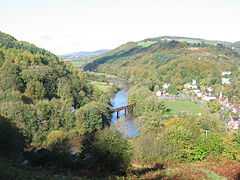Highbury Wood
| Site of Special Scientific Interest | |
|
Wild garlic and bluebells in Highbury Wood | |
 Shown within Gloucestershire | |
| Area of Search | Gloucestershire |
|---|---|
| Grid reference | SO540086 |
| Coordinates | 51°46′29″N 2°40′03″W / 51.774623°N 2.667379°WCoordinates: 51°46′29″N 2°40′03″W / 51.774623°N 2.667379°W |
| Interest | Biological |
| Area | 50.74 hectare |
| Notification | 1983 |
| Natural England website | |
Highbury Wood (grid reference SO540086) is a 50.74-hectare (125.4-acre) biological Site of Special Scientific Interest in Gloucestershire, notified in 1983.[1][2]
The site is listed in the 'Forest of Dean Local Plan Review' as a Key Wildlife Site (KWS).[3]
Location
The site, which is also a National Nature Reserve (NNR),[4] lies in the Wye Valley Area of Outstanding Natural Beauty. The woodlands of the lower Wye Valley are considered one of the most important areas for woodland conservation in Britain.[1]
Wye Valley Woodlands/ Coetiroedd Dyffryn Gwy are recognised as a Special Area of Conservation (SAC) under the EU Habitats Directive.[5][6]
Flora
The woods are a variety of types which are localised to the particular soils of the area. Most of the woodlands are a rich mixture of varieties and are the same as the original natural woods of the Wye Valley. They include rare and local species and the rarities include Large-leaved Lime, Whitebeam, and other trees close to the edge of their European range such as Hornbeam and Beech.[1]
The wood lies in a matrix of unimproved grassland and other habitats which contributes to making the Wye Valley one of the significantly diverse and most attractive areas in southern Britain. Highbury Wood overlies mostly alkaline soils and contains a range of woodland species such as Ash, Oak and Lime. It also has Whitebeam which is on the western edge of its geographical range.[1]
The ground flora is mostly Bramble, Dog’s Mercury, Bluebell and Wild Garlic. There is a range of rarer species including the Greater Butterfly Orchid.
Fauna
Two rare molluscs are reported in the wood being Phenacolimax major and Macrogastra rolphi. It is an ideal site for invertebrates and butterflies recorded include the Silver-washed Fritillary.[1]
References
- ↑ 1.0 1.1 1.2 1.3 1.4 Natural England SSSI information on the citation
- ↑ Forest of Dean District Local Plan Review, adopted November 2005, Appendix D 'Nature Conservation Site Designations Within the Forest of Dean District', Sites of Special Scientific Interest
- ↑ Forest of Dean District Local Plan Review, adopted November 2005, Appendix D 'Nature Conservation Site Designations Within the Forest of Dean District', Key Wildlife Sites
- ↑ Natural England NNR citation, map, access and facilities for Highbury Wood
- ↑ Information on Wye Valley Woodlands/ Coetiroedd Dyffryn Gwy Special Area of Conservation designation
- ↑ Joint Nature Conservation Committee Listing of Special Areas of Conservation
SSSI Source
- Natural England SSSI information on the citation
- Natural England SSSI information on the Highbury Wood units
External links
![]() Media related to Highbury Wood at Wikimedia Commons
Media related to Highbury Wood at Wikimedia Commons
- Natural England (SSSI information)
-

Highbury Wood National Nature Reserve (NNR)
-

Offa's Dyke Path in Highbury Wood
-

Highbury Wood
-

Redbrook - view from Highbury Woods
-

View to Highbury Woods
